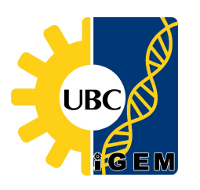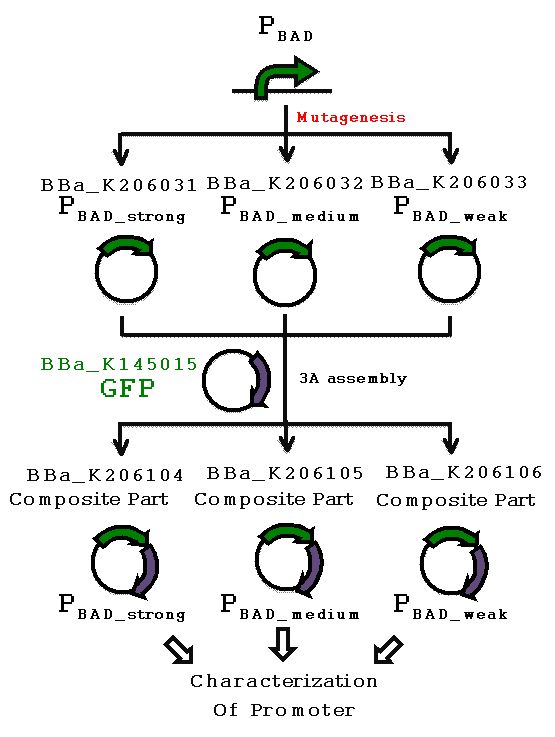Team:British Columbia/Project
From 2009.igem.org

| Home | The Team | The Project | Parts Submitted to the Registry | Modeling | Sponsor Us! | Biosensor Sensitivity Notebook | Biosensor Logic Gate Notebook | Bibliography |
|---|
Contents |
The Traffic Light Biosensor: A flexible, modular, and transparent system for multi-level assessment of variable inputs.
Biosensors have a wide variety of uses, from measuring blood glucose levels in diabetes patients to assessing environmental contamination by trace toxins. The majority of these sensors are highly specific for a single input, and their outputs often require specialized equipment such as surface plasmon resonance chips. Our project aims to create a biosensor that recognizes a given target and shifts its output fluorescence from green, to yellow, to red as concentrations approach critical levels (hence, a biological "traffic light").
Subparts:
1. A variable sensitivity biosensor
2. A lock-and-key logic gate system
Biosensor
Using data derived from random mutagenesis of the pBAD promoter binding sites (5), we intend to construct a library of varying strength pBAD promoters coupled to a reporter gene.
The Experiments
- Mutagenesis of pBAD promoter sequence.
- Quantification of mutant promoter-driven RFP fluorescence.
- BioBrick design and submission.
Results
Qualitative examination of RFP development following arabinose addition found that the weak promoter does, as expected, turn red at a significantly slower rate than the wild type promoter. However, the purported strong promoter is both slower to develop colour as well as reaching a lower maximum intensity. We are currently establishing methods for quantification and modeling of RFP induction by arabinose.
Logic Gates
In 2004, Isaacs et al. (4) constructed a lock and key system termed the riboregulator. Briefly, the riboregulator consists of a lock sequence immediately 5' of and complementary to the RBS; upon transcription, the lock binds to the RBS and prevents translation of the mRNA. This binding can be "unlocked" by the introduction of a "key" mRNA, which disrupts the binding between the lock and RBS and allows translation to resume.
We intend to convert the lock and key as described by Isaacs et al. into standardized BioBrick parts and integrate them with our library of variable strength promoters in order to create a multi-level logic gate system. We also hope to design an additional component, termed the "jammer", which prevents the key from unlocking the lock.
Lock and Key
The lock is a short DNA segment that is the reverse-complement of the lock.
Jammer
Our analog biosensor requires a component to turn off designed lights (i.e. reporter genes) when the target passes a certain threshold. To do so, we have designed a modular, endogenous RNA knockdown system using antisense RNA hybridization. We have independently conceived of using a reverse promoter, that was first described by O’Connor and Timmis (1987), to generate an antisense transcript that hybridizes to the sense transcript, to reduce gene expression.
This is accomplished at the RNA-level through both transcription and translation interfaces. First, when the reverse promoter recruits RNA polymerases, they transcribe in the antisense direction. This causes the sense and anti-sense oriented polymerases to collide, thus reducing transcription (Ward and Murray, 1979; Crampton et al. 2006).
Roadmap
Miscellaneous Data
- Biobricks.zip - Fasta file containing every biobrick from [http://partsregistry.org/cgi/partsdb/pgroup.cgi?pgroup=List Here]
- http://www.pkts.ca/bb - Biobrick digestion engine - enter the name of a biobrick plasmid and biobrick insert, and this will show you the product of an EcoRI and PstI digestion/ligation as a FASTA file (suitable for viewing in your favorite program).
- http://www.pkts.ca/brickedit/ - Biobrick picture maker - enter a sequence of letters corresponding to the icons, and the program will produce a concatenated file of the Biobrick.
Links
http://rna.tbi.univie.ac.at/ - a package of prediction tools for RNA structures; we used RNAfold to annotate the key and lock structures
http://mobyle.pasteur.fr/cgi-bin/portal.py - a set of web-accessible bioinformatics tools including Mfold, which determines 2D RNA structure and draws it
http://frodo.wi.mit.edu/ - Primer3, a primer design program
 "
"

